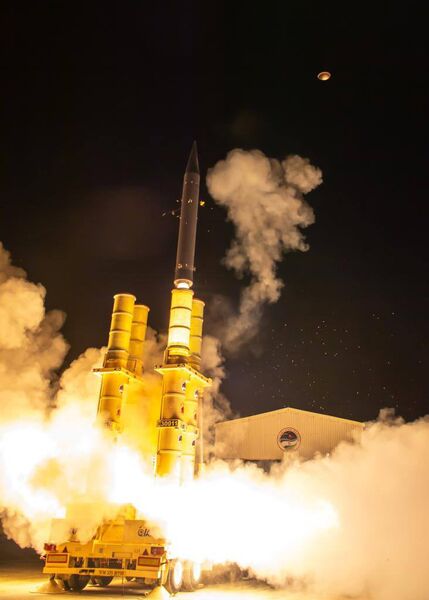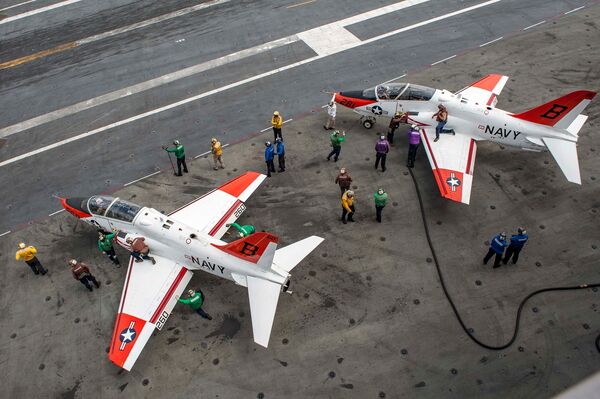- About
- Intara
- Capabilities
- Advisory
- Resources
- News
- Store
Israel's Arrow 3 makes operational debut
10 November 2023
by Jeremy Binnie


The Israeli MoD released a file photo of an Arrow 3 interceptor being launched to illustrate the first operational use of the missile on 9 November. (Israeli Ministry of Defense)
Israel used a long-range Arrow 3 exoatmospheric ballistic missile interceptor operationally for the first time on 9 November, the Israel Defense Forces (IDF) and the Israeli Ministry of Defense (MoD) announced later that day.
The Arrow 3 is one of two interceptors that can be launched by the Arrow Weapon System (AWS), the other being the Arrow 2 that is designed to counter ballistic missiles after they re-enter the Earth's atmosphere.
“Israeli Air Defense Array soldiers successfully launched an Arrow 3 interceptor operationally for the first time this evening [at a] target launched towards Israel in the Red Sea region,” the MoD said in a statement on 9 November. “This marks the Arrow 3 system's first operational interception since its operational deployment in 2017. This achievement follows the recent success of the first operational interception carried out by the Arrow 2 system last week.”
UK to consider extending Eurofighter service life to retain combat mass
16 May 2024
by Gareth Jennings


With mass and resilience key lessons from the ongoing war in Ukraine, the RAF is considering a service life extension for its Eurofighter Typhoons. (Crown Copyright)
The United Kingdom is considering a service life extension of its fleet of Eurofighter Typhoon FGR4 combat aircraft to retain its combat mass, Janes and other defence media were told on 14 May.
Speaking at the site of BAE Systems' Warton production facility in northern England, Mike Baulkwill, combat air strategy director at the company, said that, with the international Eurofighter operator base set to fly the type for decades to come, the Royal Air Force (RAF) was looking at putting back the retirement date of its aircraft as it looks to maintain combat aircraft numbers.
“[The wider operator base] will be flying the Eurofighter out into the 2060s. The RAF is now considering an extension itself, and rightly so because it needs mass,” he said. Baulkwill provided no details as to the numbers or tranche standard of the aircraft to potentially be retained.
Brazil conducts first flight of re-winged P-3AM Orion
16 May 2024
by Victor Barreira


A Brazilian Air Force P-3AM Orion. Three aircraft are to be upgraded with new wings. (Airbus Military SAS)
The first re-winged Brazilian Air Force Lockheed P-3AM Orion maritime patrol aircraft (MPA) flew on 2 May, the service announced on 13 May, a major step towards improving the P-3AM fleet's readiness rate.
Elements of the wing that were replaced during the rebuild include the top coverings, front and rear spars, and the upper panels of the central wing and fuselage structures.
Brazilian manufacturer Akaer has delivered two additional sets of wings to the Brazilian Air Force, which are being installed in another two aircraft at the Galeão Aeronautical Material Park. The project is scheduled to conclude in October 2024, Akaer said in an announcement. Whether or not Brazil intends to upgrade the P-3AM fleet beyond the three deliveries has not been publicly disclosed.
On 25 October 2018 Akaer was awarded a contract to rebuild the main wings of three Orion MPAs, the company said.
US Navy T-45 Goshawk training aircraft return to flight
16 May 2024
by Zach Rosenberg


A T-45C Goshawk attached to Training Air Wing (TW) 2 receives fuel aboard the aircraft carrier, USS George H W Bush (CVN 77). The ship is conducting sustainment exercises to maintain carrier readiness. (US Navy)
The US Navy (USN) fleet of Boeing T-45 Goshawk training aircraft has returned to flight following a month-long grounding, according to Naval Air Systems Command (NAVAIR). The type was grounded on 12 April following an engine malfunction during a training flight; the crew landed safely.
“Preliminary findings, reviewed by NAVAIR and the Naval Undergraduate Flight Training Systems Program Office, suggest the aircraft involved in the incident may have experienced an engine blade failure due to a manufacturing defect on a low-pressure compressor blade,” NAVAIR told Janes on 13 May, noting that the accident investigation was still ongoing.
As of that date, 113 T-45s had been inspected and certified safe to return to flight, said NAVAIR. An additional 41 are undergoing inspections with intent to return them to flight as soon as possible. A total of 154 engines – including spares – had been inspected.
Israel used a long-range Arrow 3 exoatmospheric ballistic missile interceptor operationally for the ...
Latest Podcasts
The value of OSINT for intelligence sharing
In this episode Harry Kemsley and Sean Corbett are joined by Phil Ritcheson Ph.D. to discuss why intelligence sharing is now more important than ever. They discuss the growing need for allied and partnership and how by using open sources facilit...
Listen nowJanes Case Studies
Using Janes Intara to build a common intelligence picture: Russian build up on the Ukrainian border
View Case StudyNews Categories
 Air Details
Air Details